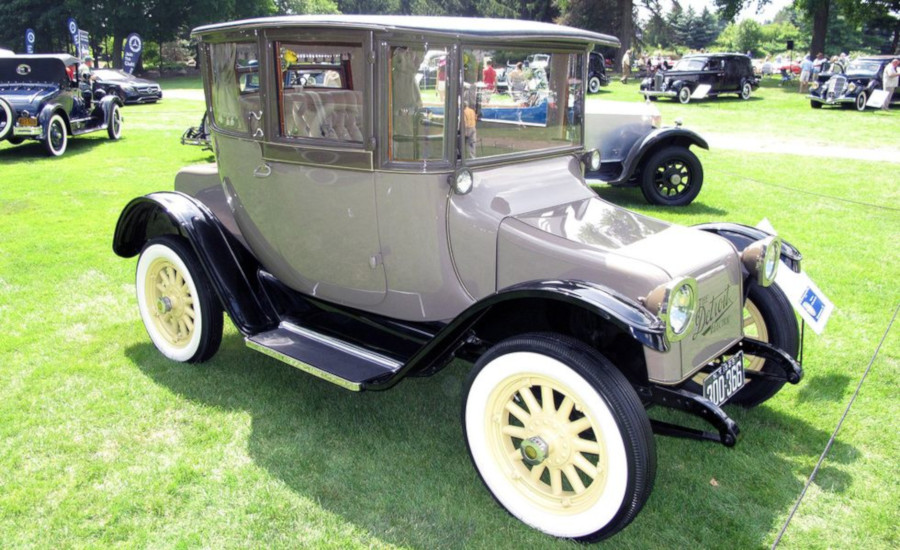by Bob Sadler, MotorCities Communications Manager
Images Courtesy of Detroit Electric, Car and Driver, and Coachbuilt.com
Published 1.26.2022
 A 1923 Detroit Electric (Kevin Wilson, Car and Driver)
A 1923 Detroit Electric (Kevin Wilson, Car and Driver)
Electric vehicles are gaining popularity in the current automotive landscape, with many manufacturers committing to build them exclusively within the next decade as they abandon the internal-combustion gasoline engine. It is interesting to note that electric cars date back to the very beginnings of the industry more than 125 years ago, and that electrics once actually dominated sales due to their superior performance and reliability.
One of the earliest and best-selling brands of electric cars was the Detroit Electric, which had its roots in the Anderson Carriage Company. Founded by William C. Anderson to make horse-drawn vehicles in Port Huron, Michigan in the 1880s, the company moved to Detroit in 1895. Anderson’s company eventually began building auto bodies for some of the early manufacturers in Detroit, and Anderson himself began considering whether to build his own entry for the growing market.
 A Detroit Electric in a California museum
A Detroit Electric in a California museum
Anderson decided on an electric drivetrain for his vehicle, and the first Detroit Electric hit the streets in 1907. A total of 125 units were produced by the end of that year, and the company introduced a closed cabin vehicle called the Inside-Drive coupe in 1908 – stimulating even more sales growth.
By 1911, the company was reorganized as the Anderson Electric Car Company to reflect its primary line of business, but they also continued to make auto bodies in support of other Detroit manufacturers as well as horse-drawn vehicles. Production of the Detroit Electric models peaked at 1,893 in 1916, making them the most popular electric vehicle on the road.
 A 1913 Detroit Electric ad
A 1913 Detroit Electric ad
The Detroit Electric brand featured battery packs in both the front and rear, with control units under the enclosed passenger cabin. The design was tall and upright, and Detroit Electrics were the first cars to have curved side glass, which eliminated blind spots for city driving. Due to the weight of the batteries, aluminum was used for the bodies.
Electric vehicles became the choice of professionals like doctors because of their instant starting capability, which could make all the difference in a medical emergency. They also were preferred by wealthy urban women because they were easy to drive and didn’t require the often-difficult turning of a crank to start, in contrast with the dirty, sometimes unreliable gasoline vehicles of the era.
Among the notable female owners of Detroit Electrics at that time were Clara Ford, the wife of Ford Motor Company founder Henry Ford, and Mrs. Henry Joy, spouse of the president of the Packard Motor Car Company. Henry Ford’s close friend Thomas Edison also drove a Detroit Electric.
 Thomas Edison and his Detroit Electric
Thomas Edison and his Detroit Electric
The Detroit Electric claimed it could run up to 80 miles on a single charge and reach a speed of 25 miles per hour, making it very city-friendly. One of its vehicles reportedly achieved 211 miles on one charge.
The popularity of electric vehicles began to wane after the invention of the electric starter by Charles Kettering made gasoline internal combustion easier to operate and more reliable. Manufacturing advances by companies like Ford also led to lower prices for gasoline-powered cars. A 1914 Ford Model T was priced under $500, and a comparable Detroit Electric cost four times as much. World War I between the years of 1914 and 1918 also caused major price increases for copper and lead, key resources used in battery production, driving electric prices even higher.
After the war, Detroit Electric shifted its focus to the production of electric delivery vehicles, which were still popular after the decline of the car business. They also continued in the production of bodies for other area automakers during the 1920s.
The Great Depression proved to be the final challenge that could not be overcome, and the last of 35,000 Detroit Electrics made was assembled in 1939.
Today, the name Detroit Electric has been revived by a new company based in the United Kingdom looking to produce a 21st Century version of the vehicle.
Bibliography
Theobald, Mark. “Anderson Carriage Company.” Coachbuilt.com, 2004.
Wilson, Kevin. “Worth the Watt: A Brief History of the Electric Car, 1830 to Present.” Car and Driver, March 15, 2018.
“History of Detroit Electric.” Detroit-electric-group.com, 2020.



